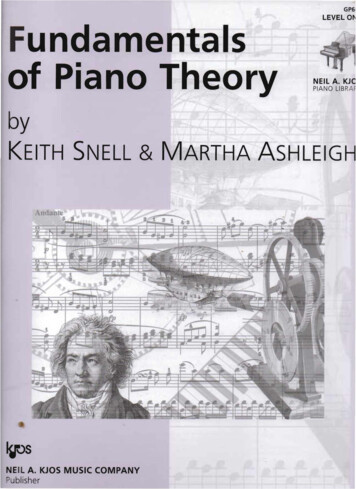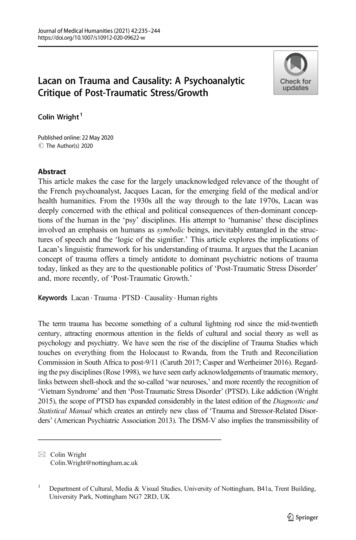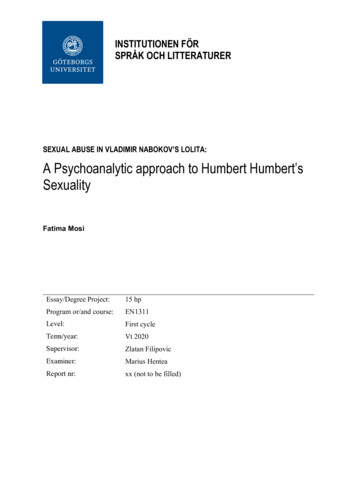
Transcription
3 daysTHE FUNDAMENTALS OF PSYCHOANALYTICTHEORY AND THERAPYDay 19:00 a.m.12 p.m.Fundamental Concepts of PsychodynamicTheory and Therapy1. Psychodynamic Sensibility & PsychoanalyticListening2. The Therapeutic Relationship: The Setting andFrame3. Clinical ApplicationsDay 12:00 p.m.4:30 p.m.Transference and Countertransference1.Theoretical Discussion2.Clinical Application
Psychoanalytic Theory and Therapy:Transference and CountertransferenceCaroline M. Sehon, M.D.Director, DC Metro ProgramInternational Psychotherapy Institutecarolinesehon@gmail.com
Object Relations Theory Way of working more than a theory Primary focus therapeutic relationship Tx relationship offers a TransferenceCountertransference microcosm Reflects the patient’s internal objectrelations set3
Object Relations TheorySelfAffectsOtherThe Object Relations DyadKernberg, Otto (2010)
Psychic Structure:Splitting of all-good from all-badS-O-SO-S O S O Kernberg, Otto (2010)
Psychic Structure: Integrated organizationO O-O O-S SO OO O-Kernberg, Otto (2010)
Transference In the era of Freud & Breuer– A hindrance to therapeutic work One-person psychology– Viewed transference as resulting from thedisplacement of infantile perceptions andwishes7
Freud’s View of Transference New editions of childhood impulses orfantasies from early attachment figures ontotherapist a “false connection” Both positive and negative transference Ubiquitous but a subject of study in therapy8
Contemporary View of Transference Present-day view– central and significant to our theory andtechnique Two-person psychology (Bi-directional field)– Total transference situation (Betty Joseph,1985)– Object relations perspective Activation of internalized object relationshipexperienced in therapeutic relationship9
Transference Transference phenomena are co-created in theunconscious configuration between patient &therapist The expression of internal object relations in therelationship with the therapist Internalized relations with significant others aremodified by patient’s defenses and fantasies(not exact representations of past relations)
Transference in Terms of Spaceand TimeSPACETimeHereThereIn TherapyIn Family In -and-nowThere-and-if-and-whenDavid E. Scharff 1998
Countertransference (CT) One-person psychology versus abi-directional field CT took its place alongside transference asa guiding system and a useful response Jointly created by patient and therapistmutually influencing one another13
Countertransference (CT) Guides us towards understanding transference Transference and CT go hand in hand & alwayspresent Therapist’s Unconscious mental container forthe transference (contained) The mode of discovery of the transference The vehicle for the resolution of transference14
Countertransference Defined Broad perspective– Therapist’s total emotional response to thepatient Classical View: Therapist focused CT– Therapist’s transference to the patient Kleinian View: Patient focused Transference– Therapist’s reaction to the patient’s transference15
Countertransference Enactment U.S. ego psychologists (J. Chused; T. Jacobs) CT initially unconscious – CT recognized bycertain kinds of actions May be first sign of unconscious feelings When an attempt to actualize thetransference fantasy elicits a CT reaction Acting in by patient and/or acting in by thetherapist16
CountertransferenceConcordant IdentificationTherapist identifies with patient’s selfexperienceComplementary IdentificationTherapist identifies with patient’sinternal and external objects
CountertransferenceContextual CTTo transference directed to our contextualholding (Environmental Mother)Focused CTTo transference directed to our centeredrelating (Object Mother)
Managing Countertransference Tolerating CT Bion – alpha function Winnicott: Hate in the CT – therapist needs to(psychologically) survive the patients’ attacks Therapeutic change Transference Interpretation Tact Timing19
Varieties of CT Rescue Fantasies Bored or Sleepy Therapist Erotic CT Incapacitating CT20
CT GeographySPACETIMEHereThereThereIn therapyIn familyIn societyNowBack thenIf-andwhen21
CT GeographyCONTAINED InpatientIn space btw In(atmosphere) therapist CTCT typeFocused ContextualCT typeEgo(self)Object22
Projective Identification andIntrojective Identification STEP 1: A Type of Transference Unconscious disavowal of self and objectrepresentation, & projection into someoneelse intrapsychic defense & interpersonalcommunication An externalization of an internal objectrelationship Patient projects a state of mind intotherapist23
Projective Identification andIntrojective Identification STEP 2 – Countertransference Therapist introjectively identifies withevoked state of mind Therapist experiences projected parts(fit between projected parts andtherapist’s repressed self or objectrepresentations) Therapist feels unlike his/her usual self24
Projective Identification andIntrojective Identification Step 3 – Containment (alpha function) Once CT becomes conscious Relative contributions of patient andtherapist? Therapist metabolizes projected parts sothey can be reintrojected by Patient Mechanism of Therapeutic Action:Restructuring the Mind25
Introjective Identification andProjective Identification.Scharff, D.; Scharff, J. (2005)
References Glen Gabbard, M.D. (2004) Long-term PsychodynamicPsychotherapy- A Basic Text. U.S.A., American PsychiatricPublishing, Inc. Kernberg, Otto (2010) “Grand Round Harborview MedicalCenter Presentation. “ Scharff, D.E., Scharff, J.S. (2005) The Primer of ObjectRelations, 2nd Edition. United States of America. JasonAronson, Inc. Scharff, D.E., Scharff, J.S. (1998) “Geography ofTransference and Countertransference” (Chaper 1) In:Object Relations Individual Therapy. United States ofAmerica. Jason Aronson, Inc.
3 daysTHE FUNDAMENTALS OF PSYCHOANALYTICTHEORY AND THERAPYDay 29:00 a.m.12 p.m.Developmental Models of the Mind1.Modes of Structuring Psychic Experience2.Clinical ApplicationsDay 22:00 p.m.4:30 p.m.Consultation to Participants’ Cases
–Total transference situation (Betty Joseph, 1985) . T. Jacobs) CT initially unconscious –CT recognized by certain kinds of actions May be first sign of unconscious feelings . 1.Modes of Structuring Psychic










